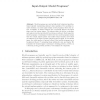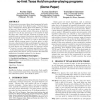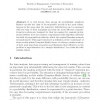689 search results - page 75 / 138 » Graphical Models for Game Theory |
ICTAC
2009
Springer
15 years 4 months ago
2009
Springer
Abstract. Model programs are used as high-level behavioral specifications typically representing abstract state machines. For modeling reactive systems, one uses input-output mode...
FC
2009
Springer
15 years 4 months ago
2009
Springer
Abstract. This paper analyzes the threat of distributed attacks by developing a two-sided multiplayer model of security in which attackers aim to deny service and defenders strateg...
AIIDE
2009
14 years 11 months ago
2009
Although in theory opponent modeling can be useful in any adversarial domain, in practice it is both difficult to do accurately and to use effectively to improve game play. In thi...
ATAL
2008
Springer
14 years 11 months ago
2008
Springer
We demonstrate two game theory-based programs for headsup limit and no-limit Texas Hold'em poker. The first player, GS3, is designed for playing limit Texas Hold'em, in ...
IPMU
2010
Springer
14 years 8 months ago
2010
Springer
It is well known that among all probabilistic graphical Markov models the class of decomposable models is the most advantageous in the sense that the respective distributions can b...



